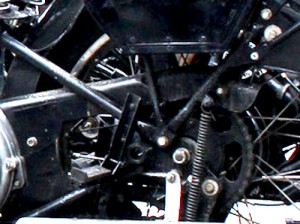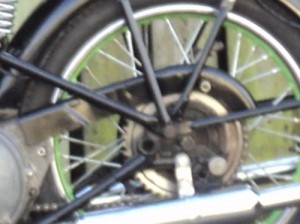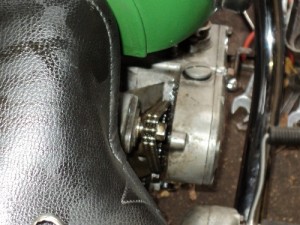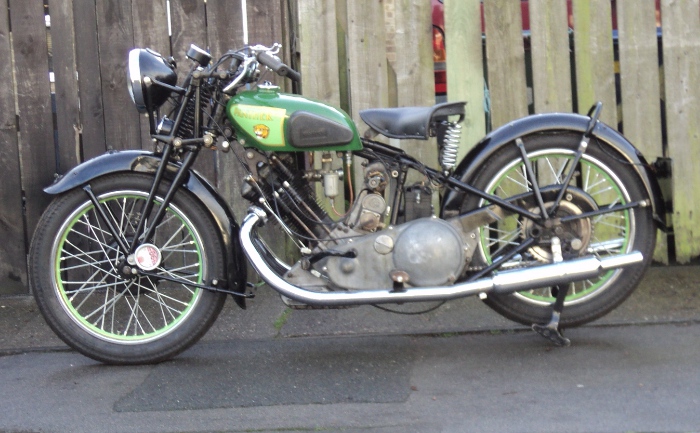As it was reasonable weatherwise today I decided to bite the bullet and try the old girl on the road.
So I kitted myself up and brought her out of the garage.
Expecting a bit of effort in starting her I put my helmet and gloves on the ground, turned on the juice, full choke, about 1/3 advance and wound her over twice to prime.
Then it was find compression and ease her over it using the valve lifter, give a “long swinging kick” and what do you know! — she starts and runs first kick!.
So I set her down to half-choke and her let warm up until she’d tick over reliably then it was put on my helmet and gloves and take her off the stand.
I went to change into first gear and found the first snag, the gear pedal is too high!.
So it was reach over and hook it into gear with the back of my heel, I can’t set the pedal further down on its splines as it will foul on the exhaust so some “adjustment” to the lever will be required.
G-R-A-U-N-C-H, The clutch was dragging!, well I think best thing for that will be new springs and re-set up with those, it was a fiddle getting an even lift with the ones I used.
Still I was in gear now so it was ease the clutch and pull away.
I went to change into second and had to take my foot off the rest to work the pedal, definitely looks like I’ll have to “adjust” the lever so it will clear the pipe!
Okay, next thing I was coming to a “T” junction so it was gear down and brake, H’mm brakes weren’t as good as they seemed on static test, maybe they just need to bed in — or perhaps a reline is in their immediate future — not only that but I can see the coupled brakes will take getting used to.
Junction was clear so it was just roll through the turn, retard the ignition a little and throttle up, engine note deepened and she pulled strongly away as I eased on the ignition advance, I’d forgotten the feel of the torque on a big Pussy!.
I pulled into the petrol station a mile down the road and put a gallon of juice in.
The bike had been running so well I decided I could put up with the gear-change for now and would put a few more miles under her belt.
So it was going round roundabouts, swinging through bends and enjoying using the sheer slogging power to pull me round them, she responded well to use of the advance lever and on the hills just “settled into the harness” and pulled on up them.
I can recall it being said in a magazine somewhere, somewhen, that a Panther might only have 26 horsepower, but these were real horses, ones with shaggy legs! (was it Titch Allen said it?, sounds like one of his comments).
I was really enjoying things until, about 12 miles out from home she lost power and I had to stop.
She turned over easily with plenty of compression so the mechanicals seemed OK. Plenty of fuel in the carb, was it electrical?.
A bit of checking of the magneto and it turned out that the magneto coupling had slipped on its taper!, if you prefer it, the timing had slipped.
Strangely enough, the first time I was out on her some thirty odd years ago the same thing happened but that was with a Lucas N1 mag and not the BTH unit she’s wearing now.
Fortunately I was within a mile of a friends house so we soon got her up to his place, he ran me home and I came back with the van to pick her up and spend a couple of hours chewing the fat with him.
Bit of a downer finish to the ride out but given about an hours work tomorrow and I’ll have her running again, I’ll lap the tapers to make sure of a good fit and clean them with a solvent cleaner to make sure the cones are absolutely clean.
It was a real pleasure to ride her again after all the years, the way she just digs in and pulls when you ask her to accelerate, the feel of riding the torque curve of the motor rather than the power curve, the lazy feel of a big, slow revving, under-square single.
I can see riding this old lady being addictive! While she’ll not be a motorway bike but she will revel in the twisties of the older road system, but after all those are the roads she was built for.





